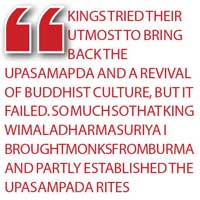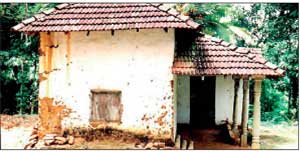Reply To:
Name - Reply Comment
 Sangharaja Welivita, who was born in the wilderness of the country in 1698 - Thumpane, in the present electorate of Galagedera, should be considered as the saviour of Buddhism in Sri Lanka. His birthplace cannot be identified as various authorities had allowed it to be renovated without retaining a trace of its originality This writer had the rare privilege to remove photographs of the original home of birth of this Thera for posterity.
Sangharaja Welivita, who was born in the wilderness of the country in 1698 - Thumpane, in the present electorate of Galagedera, should be considered as the saviour of Buddhism in Sri Lanka. His birthplace cannot be identified as various authorities had allowed it to be renovated without retaining a trace of its originality This writer had the rare privilege to remove photographs of the original home of birth of this Thera for posterity.
People are celebrating the arrival of Upasampada, two hundred and eighty years ago, from Thailand. It is recorded that at one time Upasampada was taken from Sri Lanka to Thailand and it stayed there for Welivita Saranankara Thera to agitate to bring back Upasampada to Sri Lanka.
Travelling around twenty kilometres away from Kandy, it is worth a pilgrimage to the birth place of this monk to whom there should be a debt of gratitude for having established Buddhism in this country with the help of King Kirthisri Rajasinghe. His birth place is at Welivita in the Thumpane Divsional Secretary’s Division now known as Sangharajapura.
The Sangharaja was the forerunner of a Buddhist renaissance. His birth cannot be correctly fixed. The birth is referred to as in the fifteenth year during the reign of Vimaldharmasuriya II, on the seventh day in the dark half moon of the month of Poson. Some say it is the 16th and another school of thought says it could be the 19th of June 1698.
Welivita was the son of a steady and respectable family of Kulatunges, who had lands and paddy lands to maintain themselves.
Even at the young age of five years, Welivita Sarananakara Thera would go through any script that he could get hold of and read it on a rock plate in front of this home, surrounded by paddy land. His parents did not mind his reading anything as they knew that he could not be stopped from doing so.
Within a few years, he had a thirst for knowledge and with another boy of his age set about to travel to Alagalle and stay in a rock cavern. He chooses two, one as his residence and another for his ablutions.
As time went on, he heard of one Eramuduliyadde Rala, who was living in a temple close by, one of the people banished by the King to this area. He went to him and this too very secretly as the Rala was forbidden to speak to anyone. Then Welivita heard of another who was more versed in languages, that was Murruddeniya Herath Gedera Gurunnanse.
Welivita had a thirst for knowledge and he was able to educate himself of the Burmese language, Tamil and Siamese culture. There were persons who had a knowledge of Burmese, as there was a mission of monks who came from Burma to restore the Upasampada.

The well established society that was created by King Parkarama Bahu VI who ruled the country for 53 years was broken down with the arrival of the Dutch and the Portuguese into the country. These two foreign forces were bent on conversion and teaching their languages to the people in the coastal belt. Most, got converted to Christianity and also learnt their languages.
The Dutch on the other hand, who came later into the country opened up schools which taught Latin Greek and Hebrew while discouraging the belief of Buddhism. The result was dissension among the Kings and the decline of the culture of the Sinhalese and the closing of schools and privenas.
Budhist monks disappeared from the Society and the last member of the Sangha who was conferred Upasampada rites died during the period of Sri Veera Narendrasinghe. The result was that there was not a single monk who had received Upasampada rites in the country.
The monks who were lived wayward life and were bent on practising witch craft, devil dancing and all other practices which were not Buddhism. They even got married and they were termed by the people as Ganninnanses.
Kings tried their utmost to bring back the Upasamapda and a revival of Buddhist culture, but it failed. So much so that King Wimaladharmasuriya I brought monks from Burma and partly established the Upasampada rites. The ceremony was on the Banks of Mahaweli at Getambe in Kandy. But, the rites did not last long among the monks.
The last monk who had received Upasampada rites was Sooriyagoda Thera, who subsequently was beheaded by the King, when he was given the impression that this Thera was creating an uprising.
It is in this situation that Welivita Saranankara Thera thought and created a background to bring Upasampada from Siam, present Thailand. First while he was grasping Buddhist values and learning the languages, he built a Society known as Silvats. He commenced collecting alms for his subsistence and that of his followers. With this he followed a life of Buddhist values and Buddhist rites. But, the Ganninanses and the missionaries though otherwise and carried out a campaign against Welivita Saranakara to the extent that he was planning to oust the King. But this failed and Welivita Saranankara Thera continued with his Silvat Society.
Then he thought that the time has come to be ordained and with the help of his parents, who now accepted the position of their son, thought that the best place was Sooriyagoda Temple which had been built by the King Wimaldharmasuriya. Welivita Saranankara by this time was 12-years-old and became a Samanera in this Temple. But it is said that Welivita himslef donned his own robes, without allowing Sooriyagoda Rajasundera Thera, his mentor to do the honours. Sooriyagoda Thera was the only living monk with Upasampada rites, which was conferred on him by the Burmese delegation in 1679.
In the meantime, King Narendrasinghe who had heard about the knowledge of Welivita Sarnankara Thera invited him to tutor his brother–in- law Sri Vijaya Rajasinghe, so that he would be well versed in Buddhist rites and how he could govern the country. This he thought was the best opportunity to push his idea of bringing Upasampada to the country.
Sri Vijaya Rajasinghe came on to the throne( 1730-1749) with the demise of King Narendrasinghe and Welivite Saranankara Thera was able to arrange a delegation to proceed to Thailand, which was headed by Dorengama Rala. A Dutch vessel to carry the delegation was arranged by the King, and the delegation proceeded. The delegation was composed of two officials of the King and five pupils of Saranankara Thera but on the way Dorenegama fell sick and had to be left in Batavia. The Siamese King Maha Boramkot II ( 1753-1758) was informed by the time the delegation reached Thailand that Sri Vijaya Rajasinghe had died. The Siamese King even without an audience with the delegation said that he was not prepared to send any monks from Thailand as the King had died and he did not know of his present policies. So the delegation came back empty handed.
Then King Kerthi Sri Rajasinghe ascended the Throne of the Kandyan Kingdom and was approached by Welivita Saranankara Thera for the bringing of Upasampada to the country. Though the King was deep in Hindu rites, yet he made arrangements with the Dutch and Portuguese to send the delegation in their ships. Both agreed and a delegation was sent to Thailand in 1752.
It is recorded that the King himslef came to Malwatte Poya Maluwa and selected the delegation that should go to Thailand. They were Pattipola Raterala, Ehelpola Mohottala, Eriyagama Nilame, Aiyathilade Muhandirum. There was also a Royal message to the King of Siam or Thailand.
The result was spontaneous and a thirty two member delegation was sent to Sri Lanka selected from the Sangha of Thailand, which was headed by Upali Thera. This included eight Samanera monks from Thailand or Siam and also three Ministers of State.
The delegation stayed at Godapola before they proceeded to Kandy and the Siamese monks is said to have taught the Samenera monks who were present at Godapola how to don the robes.
So the delegation headed by Upali Thera arrived at Malwatta on Esala Poya Day in1753. Immediately on their arrival arrangements were made by establishing a Simala Malaka for Upasampada ceremonies at Malwatta Maha Vihare.